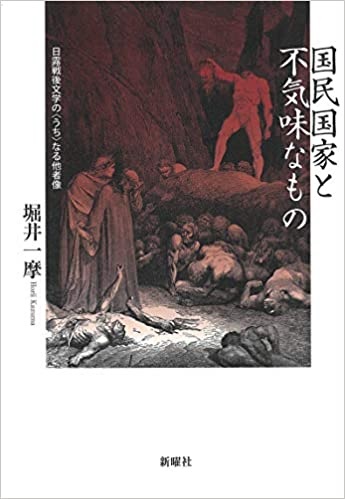
Title
Kokumin Kokka to Bukimi na Mono (The Nation State and the Uncanny - the Others Within in the Literature of the Post-Russo-Japanese War Period)
Size
408 pages, 127x188mm
Language
Japanese
Released
March 31, 2020
ISBN
9784788516786
Published by
Shinyosha
Book Info
See Book Availability at Library
Japanese Page
What is “the uncanny?” According to the teachings of psychoanalytic theory, it is that which appears to be different from us, but with which we have in fact long been familiar. It appears to be different because, due to its deviation from social standards and norms, we long ago repressed it deep within ourselves and at the margins of the societies to which we belong, making it invisible. When the repressed is triggered in some way and suddenly returns, we sense the uncanny. When we witness the uncanny, we wince, feel anxious, and at times, may try to get rid of it. However, the uncanny is not anyone else’s problem. Uncanny others are our own stifled alternate selves, representing possibilities we ourselves could not live out. Literature provides a fleeting glimpse of the uncanny that we have repressed because it violates social strictures, and by reading literary texts, we can reunite with the repressed versions of ourselves that might have been.
This work is an attempt to trace the various aspects of the uncanny that appeared in literary spaces in the Post-Russo-Japanese War Period. Part 1 deals with literary texts depicting the nationalization that took place on the occasion of the Russo-Japanese War and the uncanny things that surged out of the crevices of repression. Part 2 has to do with texts depicting the conflict between reactionary conservative politics and the uncanny in the Post-Russo-Japanese War Period, focusing on the High Treason Incident.
I would like to discuss several instances of the uncanny mentioned in the book. Izumi Kyōka’s “The Holy Man of Mount Koya” depicts the uncanny animals encountered by a wandering monk named Shūchō in a mountainous spirit world. These are the shells of broken men changed to animals by a witch who dwells in the spirit world. When “The Holy Man of Mount Koya” was published in 1900, a policy of “enriching the country and strengthening the army” was pursued in preparation for conflict with Russia, and mechanisms for national integration and mobilization were put into place. The map compiled by the General Staff Headquarters, the draft, and the national hygienics depicted in “The Holy Man of Mount Koya” were put in place on the request of the modern national army to organize human bodies into robust imperial soldiers. Situated in this context, the animalistic others in “The Holy Man of Mount Koya” represent the denationalized bodies of those reduced to a condition where they cannot fight as soldiers. By depicting Shūchō’s ambivalence toward animalistic bodies, “The Holy Man of Mount Koya” places a seal on the longing for a non-nationalized body.
Also, in the High Treason Incident—the most severe incident of false accusation in modern history—anarchists were described using metaphors of infectious diseases such as cholera and the plague that come from the outside to infect the bodies of the state. This metaphorical framework gave structure to the socialist oppression policy of the Second Katsura Cabinet and its culmination, the High Treason Incident. Kōtoku Shūsui and others were treated as an uncanny infectious disease from the viewpoint of the nation state, “quarantined” from society, and ultimately “disinfected” by means of the death penalty.
In the present day, as the pressures of inclusion into the nation and exclusion from the nation mount, it is hoped that this book will provide hints for reevaluating the concept of the nation and considering an alternative path.
(Written by: HORII Kazuma / September 14, 2021)
Related Info
The 43rd Suntory Prize for Social Sciences and Humanities (Suntory Foundation 2021)
https://www.suntory.com/sfnd/prize_ssah/



